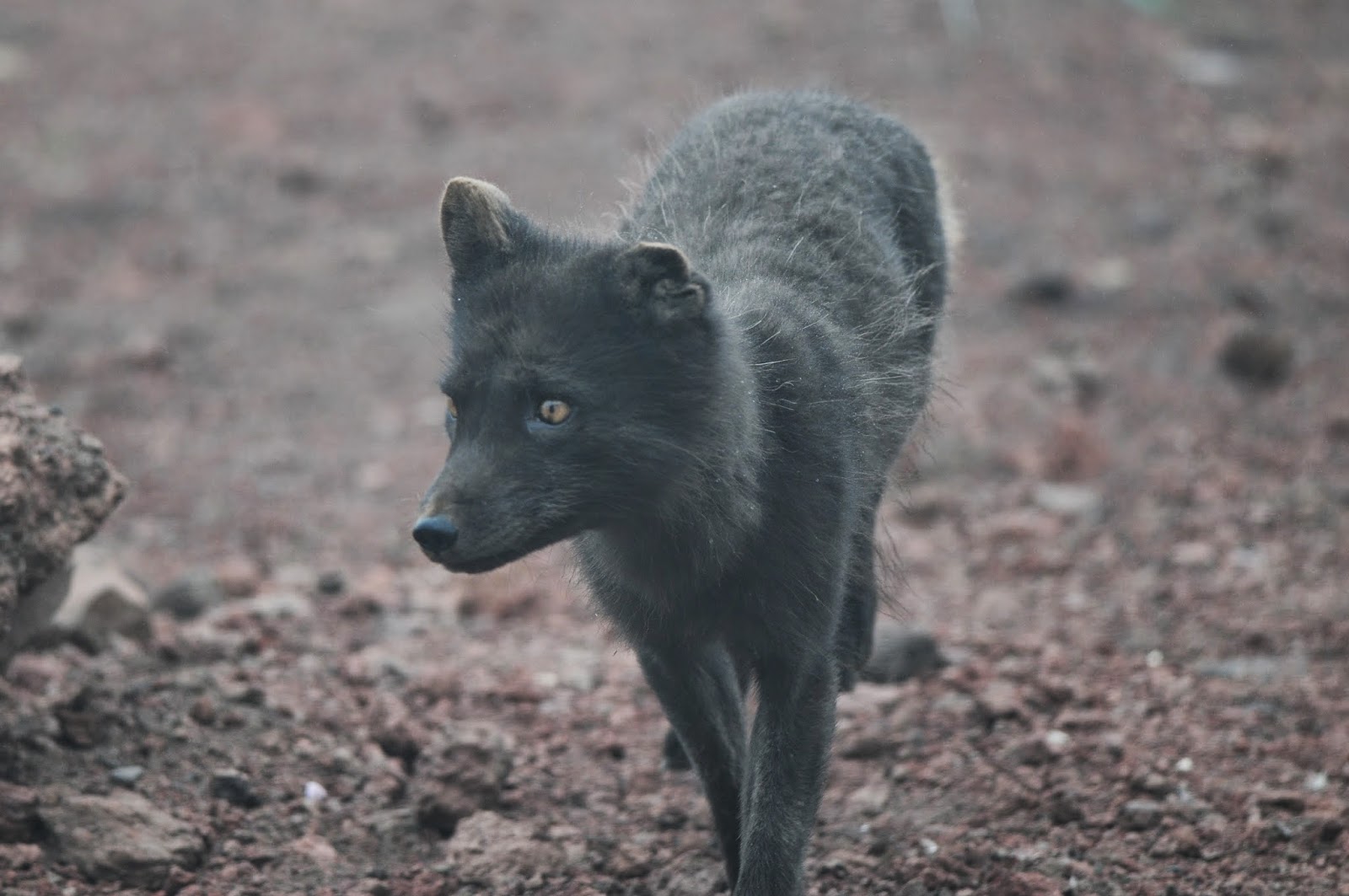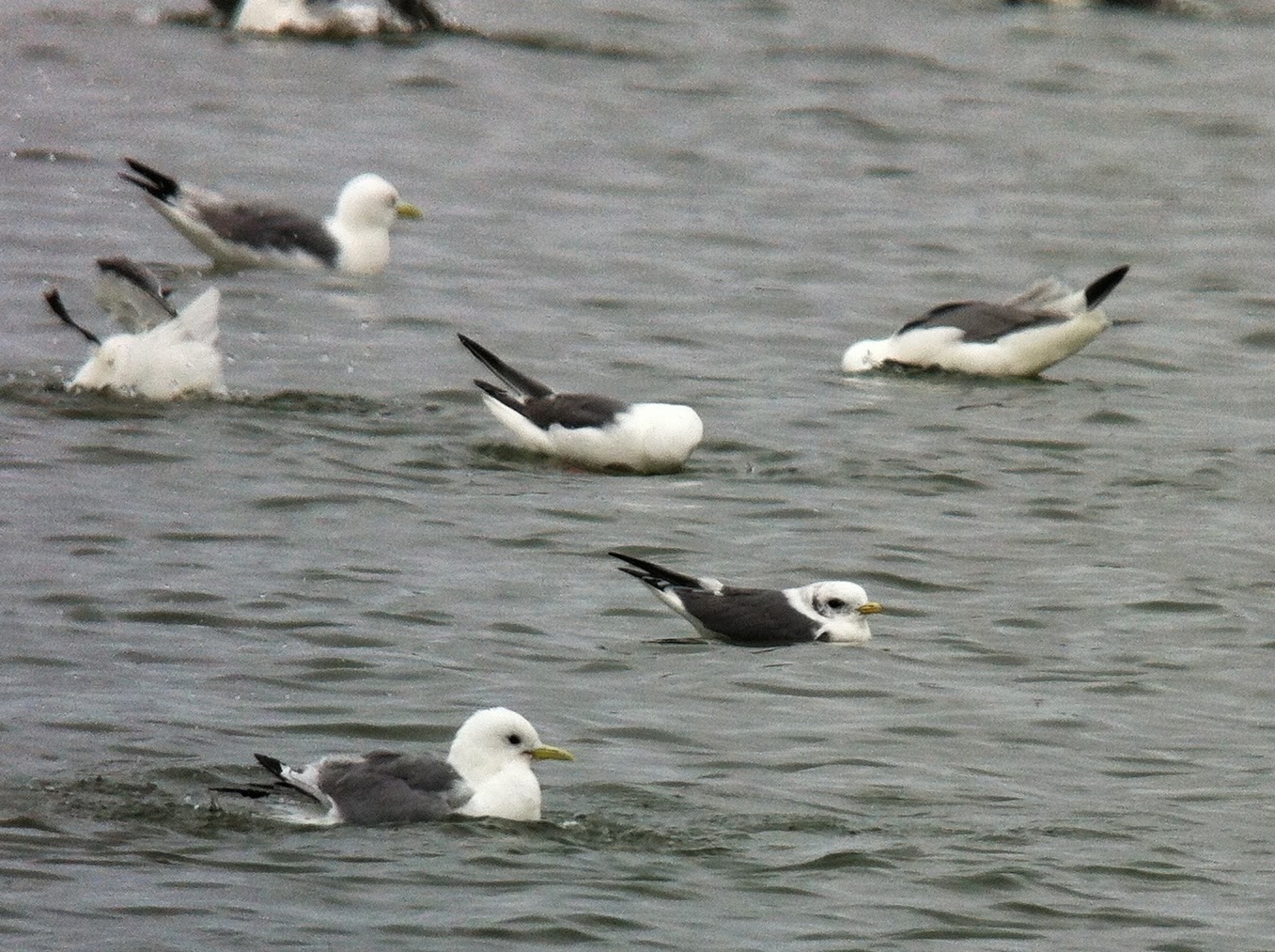Finally, I have other things to blame for not getting a
timely blog post written! Usually
it’s just my indolence but this time I get to point to our internet problems
(half the town lost their internet for a while) and the fact that I’ve actually
been working. Yes, when one of
these anchors offshore, better brace yourself:
So yes, we occasionally get cruise ships that unload 100-300
people on our shores leaving us to transport them, show them the bird cliffs, the church, etc. Sometimes they speak English,
sometimes they don’t. I’ve grown
accustomed to standing next to my scope with my finger pointing to my open Sibley Guide while Germans
line up to see their first puffin. Good times!
Oh yeah, puffins, here’s one:
While we’re on the subject of boats though, this pollock processor
ship pulled next to shore for a few minutes the other morning:
Apparently they were unloading an
injured worker before heading back out to sea. In the meantime, they were dumping offal which was
attracting a crapload of NORTHERN FULMARS… as in thousands. We scanned for an albatross or anything
else goofy but the best I could do were a couple of SHORT-TAILED SHEARWATERS
and my first (and long overdue) island POMARINE JAEGER. Here are a few fulmars though
(pretty much every bird you see is a fulmar):
I would be remiss if I didn’t mention that I… drum roll… got
to shave again already! Yes, I
managed to snag another new ABA bird just a few days ago. I found myself at Southwest Point and
although it was completely socked in with fog, we had a northwest wind at about
15 mph. I patiently waited and
sure enough, the fog started to recede for a bit. There was a light stream of NORTHERN FULMARS passing by
north to south, perhaps about 1000… and that’s when the MOTTLED PETREL flew
by. After scanning through so many
fulmars and shearwaters during the past 2-3 months, a bold pterodroma petrel
flying by was nothing short of a refreshing slap to the face. It was a truly striking bird and one that I’d desperately hoped for during my gig here. I seawatched for another couple
of hours hoping for more… and although I was granted one more Mottled, that was
about it.
Lots of the visitors spend time watching the NORTHERN FUR
SEALS from the seal blinds that we have on the island. Although the colonies are usually pretty noisy, sometimes the seals look completely dead. For
example, here’s a male (left), female (lower right), and pup (middle) that look entirely exhausted:
Sometimes the seals are somewhat close to the blind. As in….
The weather has remained quite lethargic lately; we've had no storms
and certainly no strong winds to speak of. However, we still have seen a few migrant shorebirds
coming/going. One such bird was
yet another adult RED-NECKED STINT on Pumphouse Lake that stayed for 2
days. This is already our 4th
adult RNST of the year and we haven’t even hit the season for the more-numerous
juveniles.
Tis the time for tattlers too. Having not spent a ton of time around Gray-tailed, I’ve been
studying various field marks on Wanderings. For example, this photo is plenty good enough to clinch an ID of WANDERING TATTLER if you
know what you’re looking at (for starters, focus on where the eyelines meet; maybe someday
I’ll be able to post a helpful comparison which will then give meaning to what I'm showing):
Many species are starting to molt out of their high-breeding
plumages (I’ve seen basic-plumaged Tufted Puffins and molting Pigeon Guillemots
already). Even the gaudy RED-FACED
CORMORANTS aren’t as jaw-dropping anymore. Here’s an adult but you’ll notice the reduced white on the
flanks and the lack of the two tufts on the head:
Some cormorants were never that gaudy to begin with this
year. Here’s a youngster which,
although reduced in color, is still striking when you can see the blue coming
in under the bill:
I’ll close with a remarkable flower; MONKSHOOD:
Currently, this flower is one of the most noticeable blooming plants on the island. As you can see, their deep purple color goes quite nicely with the deep greens. But hold up... there are other names for this flower such as Wolf's Bane, Leopard's Bane, and Devil's Helmet. You see, this flower is deadly poisonous. Historically, the toxins extracted from this plant were used to kill wolves, hence the name Wolf's Bane. In fact, people all around the world have used these plants for centuries for the potent poison; tribes poisoned their arrows and spears for hunting animals (ibex, tigers, foxes, bears, etc). The Chinese, well, they even used it in warfare to poison an enemies' water supply. Witches smeared Monkshood on their broomsticks and bodies, drank a dram of the herb belladonna and went "flying".The native Aleuts here in western Alaska knew of this poison too and called this plant Anisnaadam Ulax (or "Bumblebee's House"). To ensure children would stay away from it, mothers would warn the children that if they touched the flower, a bumblebee would come out and sting them. The native Aleuts would also tip their lances with Monkshood for whale hunting. Typically, one hunter in a kayak would stalk the whale and once lanced, the whale would become paralyzed and would drown.
You should wear gloves to touch any part of the plant (whoops). If you take in large doses, they say death is almost instantaneous. On that note, I'll leave you with some cut-and-pasted cultural references from Wikipedia:
- In Greek mythology, Medea attempted to poison Theseus with a cup of wine poisoned with wolfsbane. However Aegeus, his father, interceded when he discerned his identity.[19]
- Shakespeare, in Henry IV Part II Act 4 Scene 4 refers to aconite, alongside rash gunpowder, working as strongly as the "venom of suggestion" to break up close relationships.
- Wolfsbane is mentioned in one of the verses of the Wiccan Rede.
- The 1941 film The Wolf Man suggests people can become werewolves when Wolfbane blooms.
- In The Vampire Diaries, wolfsbane is the counterpart of vervain, which affects vampires, to debilitate werewolves and hybrids.
- Wolfsbane in the Harry Potter series of Fantasy novels is a toxic plant that can be used as an ingredient in the Wolfsbane Potion, a potion werewolves use to maintain their rationality and conscience when transformed into a wolf.
- In the 1931 classic horror film, "Dracula" starring Bela Lugosi as Count Dracula and Helen Chandler as Mina Seward, reference is made in regards to wolfbane (aconitum). Towards the end of the film, "Van Helsing holds up a sprig of wolfbane". Van Helsing educates the nurse protecting Mina from Count Dracula to place sprigs of wolfbane around Mina's neck for protection. Furthermore, he instructs that wolfane is a plant that grows in central Europe. There the natives use it to protect themselves against vampires. As long as the wolfbane is present in Mina's bedroom, she will be safe from Count Dracula. During the night, Count Dracula desires to visit Mina. He appears outside her window in the form of a flying bat. He causes the nurse to become drowsy and when she awakes from his spell, she removes the sprigs of wolfbane placing it in a hallway chest of drawers. With the removal of the wolfbane from Mina's room, Count Dracula mysteriously appears and transport Mina to the dungeon of the castle.[20]
- Monkshood is the poison used by the murderer in the third of the Cadfael Chronicles, Monk's Hood by Ellis Peters, published in 1980 and set in 1138 in Shrewsbury.
- An overdose of aconite was the method in which Rudolph Bloom, father of Leopold Bloom in James Joyce's Ulysses, committed suicide.
- In the NBC series Grimm, wolfsbane is rubbed on the person's skin to prevent a Blutbad (a wolf-like Wesen, or creature that a Grimm can differentiate from normal human beings) from detecting their scent.
- In the TV series Dexter (Season 7), the character Hannah McKay uses aconite to poison some of her victims.
- In the television series Midsomer Murders, season 4, episode 1 ("Garden of Death"), aconite is used as a murder weapon, mixed into fettucine with pesto to mask the taste.[21]
- In Episode 9 of the TV Series American Horror Story: Coven, the resurrected Myrtle Snow poisons former fellow Witches council members with Monkshood laced Melonballs at a private dinner party hosted by Snow herself.

















































